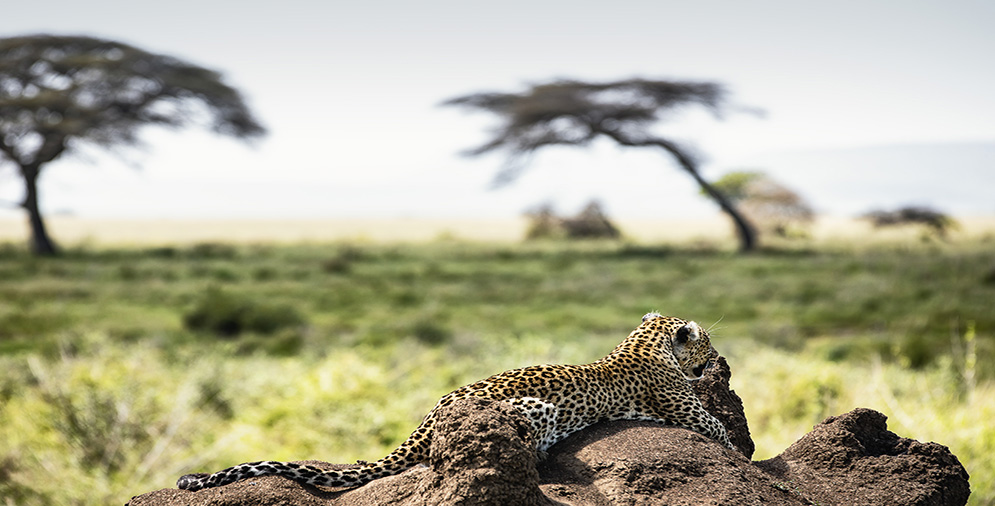Our top destinations
Serengeti National Park
The Serengeti National Park was proclaimed a national park in 1951, and designated a UNESCO World Heritage Site in 1981. It is the only place in the world where you can witness millions of migrating wildebeest over the Acacia plains, and is the closest to an untouched African wilderness you will ever get.
The word Serengeti is derived from the Maasai language meaning ‘endless plain’ and consists of vast open plains dotted by kopjes. The park is so vast that you could never see it all in one trip. Each region offers different landscapes and wildlife highlights for your safari
The Serengeti supports a magnificent diversity and abundance of animals, from the Big Five – lion, leopard, elephant, buffalo and black rhino – to giraffe, Grant’s gazelle, impala, and eland. Birders will be delighted by more than 500 species, which include kori bustard, secretary birds, Fischer’s lovebird, and so many more.
Are you ready to explore Serengeti National Park with us?
Enquiry now.
Ngorongoro Conservation Area
The Ngorongoro Conservation Area famously known as AFRICA’S GARDEN OF EDEN, is a UNESCO World Heritage Site and is characterized by a highland plateau with volcanic mountains and craters, vast savannah, and forest.
Since the whole zone is classified as a “conservation area”, and not a national park, wildlife, humans and livestock cohabit together. Ground cultivation is prohibited, but the Maasai are allowed to bring their cattle down on the crater floor for water sources and minerals.
The Ngorongoro Conservation Area is home to the world’s largest intact caldera. This three million year old caldera is considered one of the natural wonders of the world.
The crater (19 km wide, its rim rising from 365 to 490 m, total superficies of 265 km²) is the largest unflooded, intact caldera in the world. Due to its immensity and singular beauty, as well as abundance and concentration of wildlife, it constitutes for many the Garden of Eden.
An estimated 25 000 large mammals are resident in this bowl of plenty, including lion, buffalo, zebra, Thomson’s gazelle, and elephant. Leopards are most often encountered in the bountiful Lerai Forest, while cheetah move in and out of the crater. It is also the home of the most endangered black rhino.
Are you ready to explore Ngorongoro crater with us?
Enquiry now.
Tarangire national park
Tarangire National Park is considered one of the most scenic safari destinations in Tanzania. The diverse landscapes, granite ridges, woodlands, and grassland make the park unique.
Lion and other predators are frequently spotted and it is also famous for its massive population of elephants. The landscape is of particular interest too, due to the high number of scenic baobab trees.
The Tarangire National Park is known as a wonderful birding destination and also features large numbers of game, particularly during the dry season, when the Tarangire River is the only source of water in the area.
Best time to visit: July to October (dry season concentrating animals inside the park as Tarangire River is the only water source) + June, November/December
Are you ready to explore Tarangire National Park with us?
Enquiry now.
Lake Manyara National Park
Lake Manyara National Park between Lake Manyara and the Great Rift Valley, and covers an area of 325 km² including about 230 km² lake surface. It’s proximity to Arusha makes it a great place to start your safari.
The park is considered one of the best places for bird watching in Tanzania. The shallow alkaline lake and its surroundings gather an incredible number of birds. It is famously known as the seasonal home of the greater and lesser flamingos.
Lake Manyara National Park offers a wilderness experience in diverse habitats, from its Rift Valley soda lake to dense woodlands and steep mountainsides. The remarkable wildlife includes tree-climbing lions, vast elephant herds, giraffes, waterbucks, monkeys, and more.
There are also interesting sites to visit such as the treetop walkway (canopy walk), hot springs, and a boardwalk on the lake.
Best time to visit: from December to March and June to October (dry seasons)
Are you ready to explore Lake Manyara National Park with us?
Enquiry now.
Mt Kilimanjaro national park 5895m/19340ft.
Being located in Tanzania E.A and standing at 5,895m/19340feet, the majestic Mt Kilimanjaro is the highest point in Africa and tallest free-standing mountain on the earth planet. This volcanic massif stands in splendid isolation above the surrounding plains, with its snowy peak looming over the savannah. The mountain is encircled by mountain forest. Numerous mammals, many of them endangered species, live in the park.
Mount Kilimanjaro is the largest free-standing mountain rise in the world, meaning it is not part of a mountain range, also its one of the seven summits.
Mount Kilimanjaro’s three peaks were formed after volcanic eruptions millions of years ago. One volcanic cone, Shira, is now extinct and eroded, while the other two, Mawenzi and Kibo, ‘melted’ together after subsequent eruptions. Kibo is now the highest with its famous Uhuru peak at 5895m above sea level.
Hans Meyer created history when he climbed Mount Kilimanjaro and reached the summit of Kibo. In 1889, the dynamic duo, Meyer and Purtscheller, set forth on their historic expedition to Kilimanjaro accompanied by local guide Yohani Kinyala Lauwo. All in all, the expedition team consisted of Meyer, Purtscheller, Lauwo, two local headmen, nine porters, three local supervisors, and a cook.
Until now, more than 30,000climbers from every corner of the world attempt to summit Mt Kilimanjaro every year.
Do you wish to be among the people who attempt to summit Mt Kilimanjaro every year?

